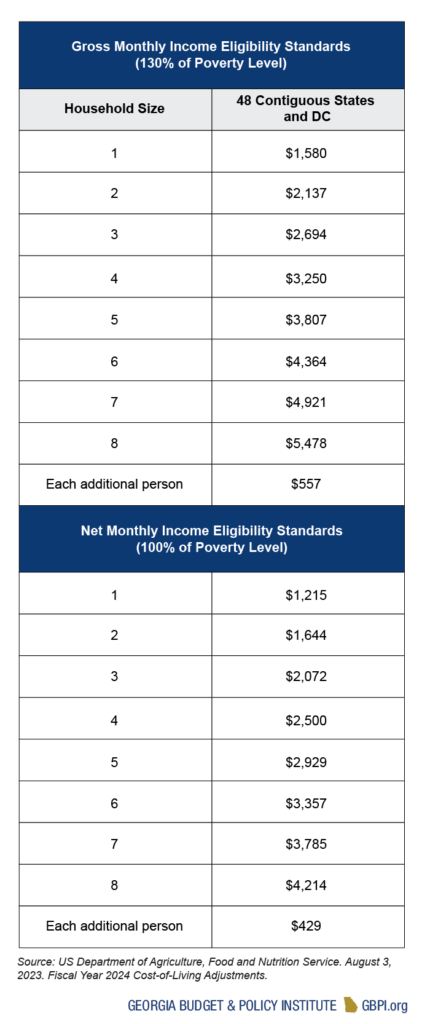Updated November 2, 2023: In accordance with the Food and Nutrition Act of 2008, the U.S. Department of Agriculture’s Food and Nutrition Service (FNS) will issue cost-of-living adjustments (COLA) for the Supplemental Nutrition Assistance Program (SNAP) at the start of each federal fiscal year. On October 1, 2023, FNS implemented the SNAP COLA for the income eligibility standards and the maximum benefit allotments. The brief below includes these updates.
The Supplemental Nutrition Assistance Program (SNAP) is a proven and effective tool to reduce food insecurity, help improve health outcomes, bolster local economies and support low-paid workers.[1] SNAP, also known as food stamps, helps about 700,000 Georgia households with a fixed income, low income, modest or unpredictable earnings afford the cost of food, especially when the economy is weak or when food costs are high.
This paper provides an overview of key SNAP issues related to eligibility and benefits, funding, the program’s role in reducing food insecurity and more.
What are the SNAP Eligibility Limits and Benefit Levels?
SNAP targets people with the lowest levels of income. However, income is one factor in determining eligibility and benefit levels. State SNAP agencies also consider major expenses like housing costs and whether certain adults are working.
Income Eligibility
There are several factors that affect SNAP eligibility. First, applicants who are not elderly (60 or older) or disabled must meet two income tests. The first test is the gross income, or total income, which must be at or below 130% of the poverty line (or $3,250 a month for a family of four). Applicants who are seniors (60 or older) or who have a disability must meet a gross income limit equal to or less than 165% of the poverty line (about $2,713 a month for a family of two).[2] In Georgia , seniors or people with a disability who receive Temporary Assistance for Need Families (TANF) Community Outreach Services (TCOS) are automatically eligible for SNAP if their gross income is within 200% of the poverty line.[3] The second test assesses if the household’s net income (gross income minus deductions like housing costs) is at or below 100% of the federal poverty line (or $2,500 a month for a family of four).
Benefits
The SNAP program assumes households spend 30% of their net income on food. Families with no net income can receive the maximum SNAP payments. For other households, benefits are determined by subtracting 30% of the family’s net monthly income from the maximum benefit.[4] A typical SNAP household receives about $6 per person per day each month.
Time Limits and Work Reporting Requirements
One of the policies that is particularly harmful for participants in the SNAP program is the time limit that is enforced when individuals do not meet the work reporting requirement. Adults aged 18 to 52 without a disability and not living with children are subject to this requirement. Requirements include working, enrolling in an approved training program or volunteering at a nonprofit for at least 20 hours a week. Adults subject to the reporting requirement have three months to receive SNAP if they are not fully complying with this requirement or do not meet an exemption.[5] If a person is cut off from SNAP because of the time limit, they do not qualify for the program for three years. According to the Georgia Department of Human Services (DHS), there were about 87,000 SNAP adults who were subject to these work reporting requirements in June. (At the time of publishing, GBPI did not have state data on how many additional people were subject to this requirement after the changes made in September and October 2023. See text box). DHS data show that counties with the highest share of these adults reside in the southwest region of the state, which is the region most at risk of seeing people lose SNAP benefits. Additionally, southwest Georgia has high levels of Black residents and historically high poverty rates.

New Federal Law Increases the Age of Adults Subject to the Work Rules and Expands Exemptions from the Requirements
Changes in the Fiscal Responsibility Act (FRA), the debt ceiling agreement which Congress passed in the spring of 2023, will increase the age, from 49 to 54, of adults who need to document their work hours or exemption status or be cut from SNAP. The age increase will phase in over time. In September 2023 the age extended to 50, and in October 2023 the age extended to 52. The final age extension will phase in in October 2024. After the phase-in period, an estimated 19,000 older adults would be expected to comply with work reporting rules.a
The FRA also expanded the exemptions to the time limit. Starting September 1, 2023, these new exemptions include veterans, people who are unhoused and youth up to age 24 who have aged out of foster care.
a. Bergh, K., & Rosenbaum, D. (2023, May 31). Debt ceiling agreement’s SNAP changes would increase hunger and poverty for many older low-income people; new exemptions would help some others. Center on Budget and Policy Priorities.
Who Receives SNAP in Georgia?
According to DHS nearly 694,000 Georgia households, or 1.4 million clients, participate in SNAP.[6] It reaches seniors, people with disabilities, families with children and adults not living with children. About 44% of SNAP households have either a senior or a disabled adult, and about 41% of households have a child (these numbers are not mutually exclusive). Households receiving SNAP benefits have very low incomes. In 2020, about 85%of SNAP households had income at or below the poverty line with about 42% in deep poverty, half the poverty line.[7]

Race and Ethnicity
Georgians of various races and ethnicities utilize the SNAP program. However, Black families and individuals are overrepresented on the SNAP rolls. In 2020, Black people comprised 33% of the state’s population and more than half of SNAP clients.[8] Critical to understanding this dynamic is the historical and ongoing discrimination and racism in our labor and housing markets and other systems that trap many Black workers in low-paid and unstable jobs and poor housing conditions with high rents.[9] These conditions increase the likelihood of Black Georgians accessing SNAP and other public benefits.
Latinx families and individuals also struggle with low pay and poor housing, yet in 2020, they only made up about 1% of SNAP clients. However, there are reasons that may explain this low usage. The program does not extend eligibility to undocumented residents, many of whom are Latinx. However, undocumented parents can still access SNAP for their citizen children. Also, former President Trump’s public charge rule, which was still in place in 2020, influenced many immigrant families to withdraw their children from SNAP.[10] That rule has since been rescinded, but research finds that adults from mixed-status families are still hesitant to sign up for benefits for which they are eligible.[11] Additionally, anti-immigrant sentiment in the mid-1990s led Congress to limit broad immigrant access to public benefits.[12] Specifically, the Personal Responsibility and Work Opportunity Reconciliation Act of 1996 includes a five-year waiting period for legal permanent residents to access food and cash benefits.[13]

How is SNAP Funded and Structured?
The federal government pays 100% of SNAP benefits to households enrolled in the program. The federal government and the state equally share the administrative cost. In Federal Fiscal Year 2021, the middle of the pandemic, the federal government spent about $105 billion nationally on SNAP payments to households.[14] That included spending on the regular program (about $63 billion) and additional SNAP funding from federal relief legislation ($42 billion). The enhancements Congress made during the pandemic ended nationwide in May 2023.
SNAP is designed to provide benefits to all eligible applicants, allowing the program to reach many households that are food insecure. However, administrative challenges and poor customer service often create barriers for qualifying applicants trying to access SNAP. In 2018, the Food and Nutrition Service, the US Department of Agriculture (USDA), the federal agency that oversees SNAP, found Georgia’s SNAP program reached 84% of all eligible people (just slightly higher than the national average of 82%).[15] Yet, the state only reached about 70% of eligible working people and about 39% of the elderly (below the national averages of 74% and 42%, respectively).
What is SNAP’s Impact on Food Security?
Feeding America estimates that in 2021, about 1.2 million people in Georgia were food insecure.[16] The USDA, the federal agency that oversees SNAP, defines food insecurity as “household-level economic and social condition of limited or uncertain access to adequate food.”[17] Among those who are food insecure in Georgia, an estimated 63% of those people had incomes above 130% of the poverty line (about $36,000 a year for a family of four), while about 37% of people were below that threshold.
SNAP is one of the nation’s strongest anti-hunger programs. Research finds that the program reduces the likelihood of being food insecure by 30%.[18] One study found food insecurity fell by one-fifth when a household participated in SNAP and that food insecurity fell by about a third among children after six months of SNAP receipt.[19] It is particularly important during economic downturns as it readily responds when more households lose earnings and struggle to afford food.
What is SNAP’s Impact on Health and Wellbeing?
SNAP helps support family economic security, health and child well-being. For example, annually between 2014 and 2018, SNAP lifted 304,000 Georgians, including 138,000 children, above the poverty line.[20] Researchers have identified several health and child development benefits to SNAP as well, including:
- Compared to similar mothers and children who did not participate in SNAP, the children of mothers who utilized SNAP while pregnant had better birth outcomes and better long-term health. The same study also found these children had greater financial security as adults than the comparison group;[21]
- Seniors who use SNAP are better able to afford their fully prescribed medication compared to other seniors with low income who did not have SNAP;[22] and
- SNAP participants incur about 25% less in medical costs in a year compared to non-participants.[23]
What is SNAP’s Impact on Communities and the State?
There are about 9,600 retailers in Georgia that participate in SNAP.[24] They range from superstores like Wal-Mart, traditional supermarkets, convenience stores and farmers markets and are located in rural, suburban and urban communities. The Center on Budget and Policy Priorities estimates these local retailers redeemed about $2.1 billion in SNAP benefits in 2019.[25] Furthermore, data from the USDA show that during an economic downturn, $1 of SNAP generates about $1.50 in economic activity.[26]
SNAP is uniquely important outside of large metropolitan areas. In Georgia, rural communities and small towns utilize SNAP at higher rates than larger urban areas.[27] About 195,000 households in counties with fewer than 50,000 people receive SNAP.[28] In rural areas, SNAP helps people meet their basic needs as jobs are often scarce, and people may struggle with unstable work and low wages. SNAP is also critical to local economies as it helps retail food stores stay open, which preserves jobs and ensures rural residents don’t have to drive even farther to shop for food. Furthermore, the federal government covers 100% of SNAP benefits (states and the federal government share equally in the administrative costs). Therefore, limiting or reducing benefits keeps out federal dollars that would boost these local economies.

Endnotes
[1] Ratcliffe, C., & McKernan, S. M. (2010, April). How much does SNAP reduce food insecurity? US Department of Agriculture, Economic Research Service. https://www.ers.usda.gov/publications/pub-details/?pubid=84335#:~:text=The%20results%20suggest%20that%20receiving,of%20reducing%20food%2Drelated%20hardship
Carlson, S., & Keith-Jennings, B. (2018, January 17). SNAP is linked with improved nutritional outcomes and lower health care costs. Center on Budget and Policy Priorities. https://www.cbpp.org/research/food-assistance/snap-is-linked-with-improved-nutritional-outcomes-and-lower-health-care
Cheyne, A., & Vollinger, E. (2022, April 22). New data underscore importance of SNAP benefit redemptions during covid-19. Food Research & Action Center. https://frac.org/blog/new-data-snap-benefit-redemptions
Center on Budget and Policy Priorities. (2018, December 4). Workers from a wide array of occupations use SNAP. https://www.cbpp.org/research/food-assistance/workers-from-a-wide-array-of-occupations-use-snap
[2] US Department of Agriculture, Food and Nutrition Service. (2022, August 9). SNAP. Fiscal Year 2023 Cost-of-Living Adjustments. https://fns-prod.azureedge.us/sites/default/files/resource-files/snap-fy-2023-cola-adjustments.pdf#page=2
[3] Georgia Divisions of Family and Children Services. 2023, June. Categorical eligibility. Food Stamp (SNAP) Policy Manual. http://odis.dhs.state.ga.us/ViewDocument.aspx?docId=4000837&amp%3Bamp%3Bamp%3BverId=1. TANF Community Outreach Services (TCOS) provides information and referral services to low-income support programs.
[4] US Department of Agriculture, Food and Nutrition Service. SNAP Eligibility.
[5] Current exemptions include:
- Clients under 18 or over 49 as of July 2023, over age 50 as of September 2023, over age 52 as of October 2023 and over age 54 as of October 2024;
- Pregnancy;
- A documented disability;
- Participation in a substance use treatment program;
- Considered physically or mentally unfit with verification; and
- Caring for an incapacitated adult or a child not living in the home of the client
The Fiscal Responsibility Act of 2023 created 3 new exemptions: Veterans, people who are experiencing homelessness and youth who are aging out of the foster care system, up to age 24 (In Georgia, the foster care exemption goes up to age 26.) These new exemptions go into effect September 2023.
[6] Georgia Department of Human Services June 2023 data.
[7] Center on Budget and Policy Priorities. (2023, February 13). Georgia: Supplemental Nutrition Assistance Program. https://www.cbpp.org/sites/default/files/atoms/files/snap_factsheet_georgia.pdf
[8] Division of Family and Children Services, Planning, Performance & Reporting Section. 2020. Georgia Division of Family & Children Services state fiscal year 2020 – Descriptive data by county. Georgia Department of Human Services. https://dfcs.georgia.gov/dfcs-descriptive-data-reports-year
[9] Bertrand, M., & Mullainathan, S. (2003, July). Are Emily and Greg more employable than Lakisha and Jamal? A field experiment on labor market discrimination. National Bureau of Economic Research. https://www.nber.org/papers/w9873
Wilson, V., & Darity Jr., W. (2022, March 25). Understanding black-white disparities in labor market outcomes requires models that account for persistent discrimination and unequal bargaining power. Economic Policy Institute. https://www.epi.org/unequalpower/publications/understanding-black-white-disparities-in-labor-market-outcomes/
Rothstein, R. (2017). The color of law: A forgotten history of how our government segregated America. Liveright.
[10] Public charge is one of the determining factors the United States considers when a person legally requests admission to the country or for people in the U.S. trying to gain lawful permanent resident status (i.e., obtain a green card). U.S. immigration officials have used “public charge” for decades to refer to a person who primarily depends on the government for subsistence, as demonstrated by either receipt of public cash assistance or long-term institutionalization at government expense. According to the Center on Budget and Policy Priorities, the Trump-era “’public charge’ rule directs immigration officials to reject applications from individuals who seek to remain in or enter the United States lawfully if they have received — or are judged more likely than not to receive in the future — need-based benefits such as SNAP (food stamps), Medicaid, and housing assistance.”
Gonzales, S. (2020, May 6). Administration should reverse anti-immigrant policies that will worsen impacts of health and economic crises. Center on Budget and Policy Priorities. https://www.cbpp.org/research/immigration/administration-should-reverse-anti-immigrant-policies-that-will-worsen-impacts
[11] Gonzalez, D. & Bernstein, H. (2023, August 17). One in four adults in mixed-status families did not participate in safety net programs in 2022 because of green card concern. Urban Institute. https://www.urban.org/sites/default/files/2023-08/One%20in%20Four%20Adults%20in%20Mixed-Status%20Families%20Did%20Not%20Participate%20in%20Safety%20Net%20Programs%20in%202022%20Because%20of%20Green%20Card%20Concerns.pdf.
[12] Fix, M., & Passel, J. (2002, January). The Scope and Impact of Welfare Reform’s Immigrant Provisions. Urban Institute. https://www.urban.org/sites/default/files/publication/60346/410412-Scope-and-Impact-of-Welfare-Reform-s-Immigrant-Provisions-The.PDF
[13] Ibid.
[14] Center on Budget and Policy Priorities. (2022, June 3). Policy basics: The Supplemental Nutrition Assistance Program (SNAP). https://www.cbpp.org/research/food-assistance/the-supplemental-nutrition-assistance-program-snap.
[15] US Department of Agriculture, Food and Nutrition Service. SNAP participation rates by state, all eligible people (fy 2018). https://www.fns.usda.gov/usamap
[16] Feeding America. (2023, May). Food insecurity among overall (all ages) population in Georgia. https://map.feedingamerica.org/county/2021/overall/georgia
[17] US Department of Agriculture, Economic Research Service. (2022, October 17). Definitions of food security. https://www.ers.usda.gov/topics/food-nutrition-assistance/food-security-in-the-u-s/definitions-of-food-security/
[18] Ratcliffe, C., & McKernan, S.M. (2010, April). How much does SNAP reduce food insecurity? US Department of Agriculture, Economic Research Service. https://www.ers.usda.gov/publications/pub-details/?pubid=84335#:~:text=The%20results%20suggest%20that%20receiving,of%20reducing%20food%2Drelated%20hardship
[19] Mabli, J., Ohls, J., Dragoset, L., Castner, L. & Santos, B. (2013). Measuring the effect of Supplemental Nutrition Assistance Program (SNAP) participation on food security. US Department of Agriculture, Food and Nutrition Service. https://www.fns.usda.gov/measuring-effect-snap-participation-food-security-0
[20] Hall, L., & Nchako, C. (2023, February 13). A closer look at who benefits from SNAP: State-by-state fact sheets. Center on Budget and Policy Priorities. https://www.cbpp.org/research/food-assistance/a-closer-look-at-who-benefits-from-snap-state-by-state-fact-sheets#Georgia
[21] Hoynes, H., Schanzenbach, D., & Almond, D. (2012, November). Long run impacts of childhood access to the safety net. National Bureau of Economic Research. http://www.nber.org/papers/w18535
[22] Srinivasan, M., & Pooler, J. (published online 2018, January 10). Cost-related medication nonadherence for older adults participating in SNAP, 2013–2015. American Journal of Public Health. http://ajph.aphapublications.org/doi/10.2105/AJPH.2017.304176
[23] Berkowitz, S., Seligman, H., & Basu, S. (2017). Impact of food insecurity and SNAP participation on healthcare utilization and expenditures. University of Kentucky Center for Poverty Research Discussion Paper Series, DP2017-02, http://uknowledge.uky.edu/cgi/viewcontent.cgi?article=1105&context=ukcpr_papers
[24] US Department of Agriculture, Food and Nutrition Service. (January 9, 2023). SNAP retailer locator data. U.S. Department of Agriculture. https://usda-fns.hub.arcgis.com/datasets/USDA-FNS::snap-store-locations/explore?filters=eyJTdGF0ZSI6WyJHQSJdfQ%3D%3D&location=32.778220%2C-82.144790%2C7.89
[25] Center on Budget and Policy Priorities. SNAP is an important public-private partnership. https://www.cbpp.org/snap-is-an-important-public-private-partnership#Georgia
[26] Cheyne, A., & Vollinger, E. (2022, April 22). New data underscore importance of SNAP benefit redemptions during covid-19. Food Research & Action Center. https://frac.org/blog/new-data-snap-benefit-redemptions
[27] Food Research & Action Center. (2023). Table 2. Household SNAP participation in metro, small town, and rural counties, by state, 2017-2021. https://frac.org/maps/snap-state-map/tables/snap-states-tab2.html
[28] Georgia Department of Human Services June 2023 data.









